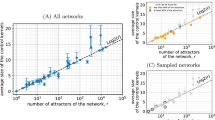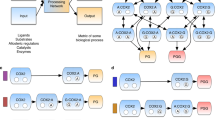Abstract
IN a complex biological interaction, of the enzyme–substrate type, the enzyme may be considered to be formally analogous to a quantum “measuring apparatus” and the substrate to a collection of observables which characterize the substrate. When a “perturbation” is induced in such a system, the “perturbed” values of the substrate observables will be recorded by the respective “measuring apparatus”. Thus a new type of interaction may be formally derived: the interaction between a “perturbed” substrate, S*, and the corresponding unperturbed enzyme1.
This is a preview of subscription content, access via your institution
Access options
Subscribe to this journal
Receive 51 print issues and online access
$199.00 per year
only $3.90 per issue
Buy this article
- Purchase on Springer Link
- Instant access to full article PDF
Prices may be subject to local taxes which are calculated during checkout
Similar content being viewed by others
References
Comorosan, S., Enzymologia, 35, 117 (1968).
Rosen, R., Bull. Math. Biophys., 30, 481 (1968).
Comorosan, S., and Murgoci, P., Bull. Math. Biophys., 31, 623 (1969).
Comorosan, S., Vieru, S., and Sandru, D., Intern. J. Rad. Biol., 17, 105 (1970).
Author information
Authors and Affiliations
Rights and permissions
About this article
Cite this article
COMOROSAN, S. New Mechanism for the Control of Cellular Reactions: the Biochemical Flip-flop. Nature 227, 64–65 (1970). https://doi.org/10.1038/227064a0
Received:
Revised:
Issue Date:
DOI: https://doi.org/10.1038/227064a0
This article is cited by
-
Structural studies on serum albumins under green light irradiation
European Biophysics Journal (2010)
-
Green light effects on biological systems: a new biophysical phenomenon
Journal of Biological Physics (2009)
-
Some thoughts on quantum non-demolition measurements in biological systems
Bulletin of Mathematical Biology (1982)
-
On a possible biological spectroscopy
Bulletin of Mathematical Biology (1975)
-
A quantum model for controlled enzymic reactions: II. Controlled biochemical networks
The Bulletin of Mathematical Biophysics (1971)
Comments
By submitting a comment you agree to abide by our Terms and Community Guidelines. If you find something abusive or that does not comply with our terms or guidelines please flag it as inappropriate.



